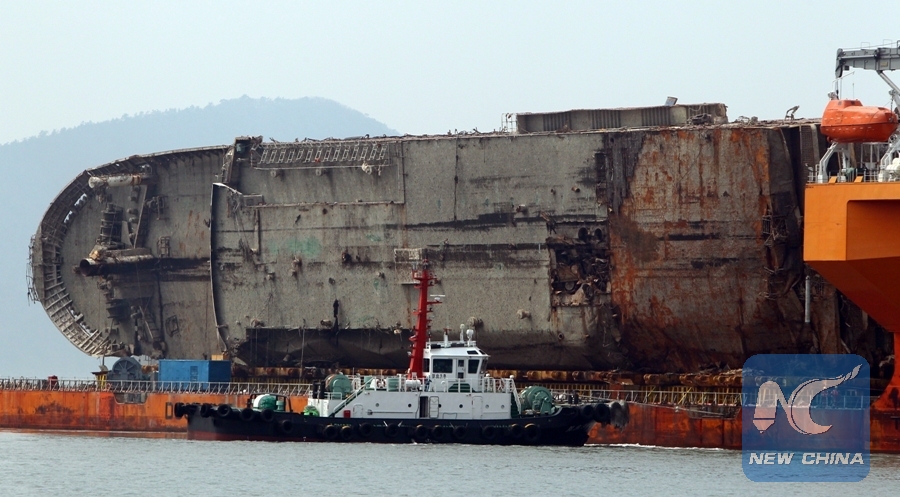
The remains of sunken South Korean passenger ferry Sewol arrives at a port in Mokpo, some 90 km away from the Jindo Island, South Korea, March 31, 2017. (Xinhua/Yao Qilin)
SEOUL, March 31 (Xinhua) -- The ill-fated South Korean passenger ferry Sewol finally ended a long-running ordeal as it came out of water and was moved to a port on Friday to get to the bottom of the country's worst maritime disaster.
Sewol was raised from the waters off Jindo Island last week, nearly three years after the ferry carrying 476 people sank on April 16, 2014. A semi-submersible transport vessel moved the salvaged ferry to a port in Mokpo, around 90 km away from the site, at about 1:00 p.m. local time on Friday.
In the early morning hours, the transport vessel was preparing to set sail for the port. Families of the nine missing passengers get on a ship offered by the oceans ministry to follow the Sewol's last journey to Mokpo.
Among the total, only 172 people were rescued from the sinking ferry. Over 300 people were killed, mostly high school students on a school trip to the southern resort island of Jeju. Nine bodies were never recovered.
It was raining and still covered with a veil of darkness when the transport ship was about to depart, according to a pool report. The families of the missing looked tired as if they tossed and turned all night.
"I didn't sleep at all. I ate little. (My husband) is about to go to Mokpo after having stayed in the scary, deep sea for three years," said Yoo Baek-hyung, whose husband was the teacher of Danwon High School in Ansan, outside of Seoul. Her husband is still unaccounted for.
As the Sewol was salvaged and would be transported to a dry dock in Mokpo for inspection, she hoped to find a strand of her husband's hair or a wedding ring on his hand.
On the way to Mokpo, some continued to wipe away tears while others called their missing families, saying "Let's go home. Let's go home now." They comforted each other during the last journey as they shared deep wounds while awaiting the salvage together.
The Sewol was escorted by five patrol boats of the coast guard, accompanied by 10 vessels carrying the bereaved families and the families of the missing people.
On the deck of one of the family-carrying boats, Park Eun-mi, whose daughter Huh Dah-yoon is still unaccounted for, said nobody must go through the same as what they have suffered in the past three years.
When she got to know the disaster occurred in 2014, she hurriedly moved to the island without realizing that her wait would be so long. Since then, she has cherished her daughter in her heart.
"Time has passed so long. It would have been better if my daughter came back to me earlier. It was the very long school trip," said the mother who had a plan to say sorry to her daughter if her body is found, as she did nothing but to await her child. And, she will say thanks to her daughter for the comeback.
The Sewol's last journey ended at about 1:00 p.m., anchoring at the Mokpo port to be mounted onto a dry dock. It was aimed to search the missing bodies and determine the clear cause of the disaster.
Shanghai Salvage, a Chinese company which had led the salvaging operation, said its team will focus on the final landing of the ferry to make the complicated, time-consuming task successful. The task is forecast to come to an end next Thursday.
"I myself am a father and deeply love my family. I know there might be young victims trapped in the ferry," an engineer of the Shanghai Salvage participating in the salvaging operation, told Xinhua.
The engineer said he and his colleagues had always kept in mind their goal of sending the missing people back home as their parents are waiting there.
Lee Kum-hee, mother of Cho Eun-hwa of Danwon High School who was never recovered, said her only wish was to become the bereaved families like others.
Lee said former President Park Geun-hye faced what she deserved as Park, as the country's president, should have served as the "parent" for all of South Koreans including the victims of the ferry disaster.
Park was arrested early Friday, hours before the transport vessel carrying the Sewol set sail for the Mokpo port.
The first South Korean female president was under harsh criticism as her whereabouts were unknown for seven hours of the day when the ferry tragedy unfolded. The initial bungling of rescue operations was believed to have increased the number of deaths.
Public dissatisfaction with the rescue operations contributed to the removal of Park from office on March 10. Park became the first South Korean leader to be ousted through impeachment.

